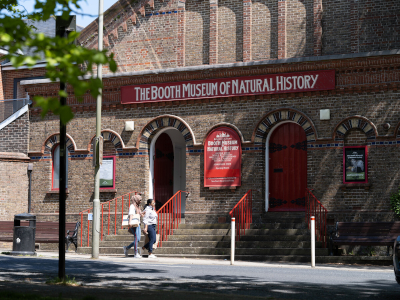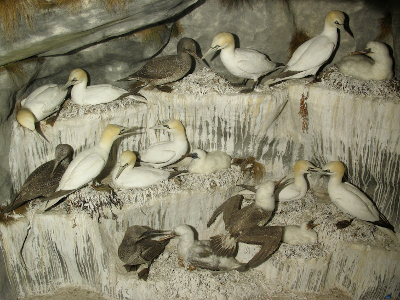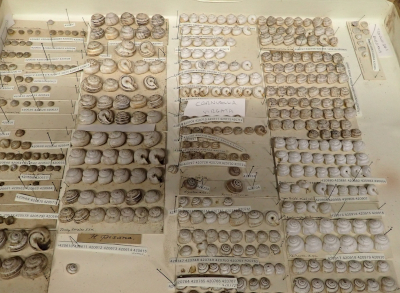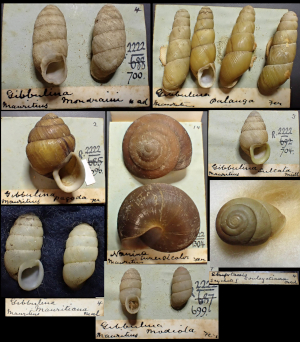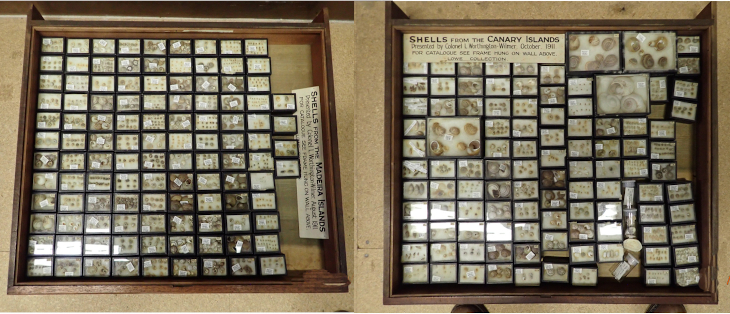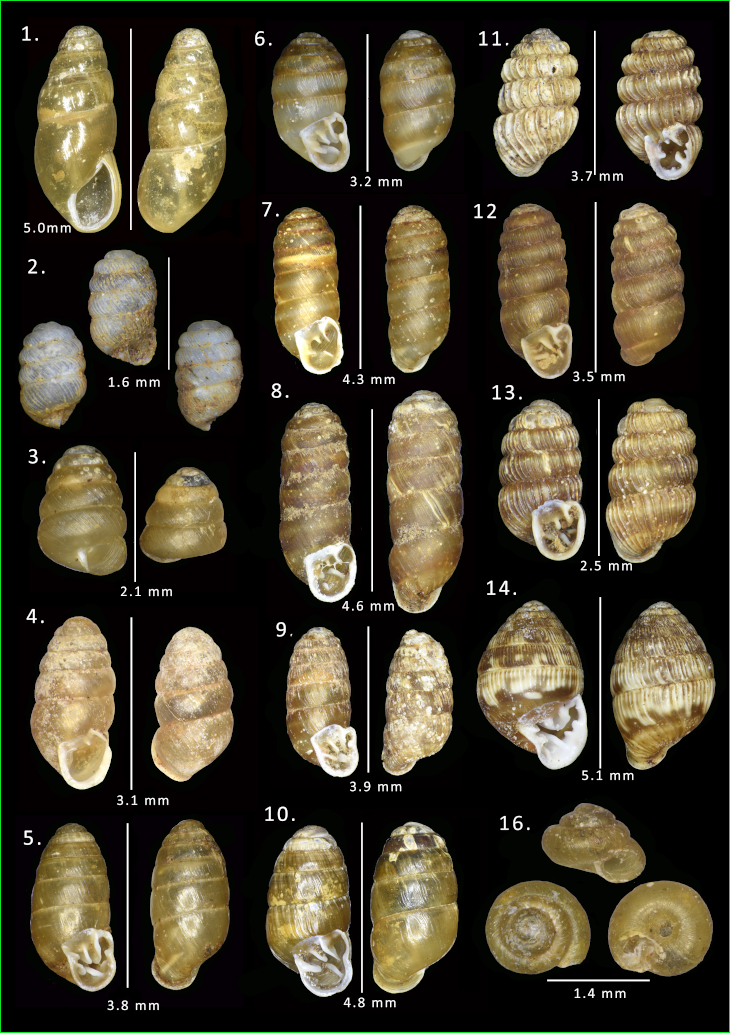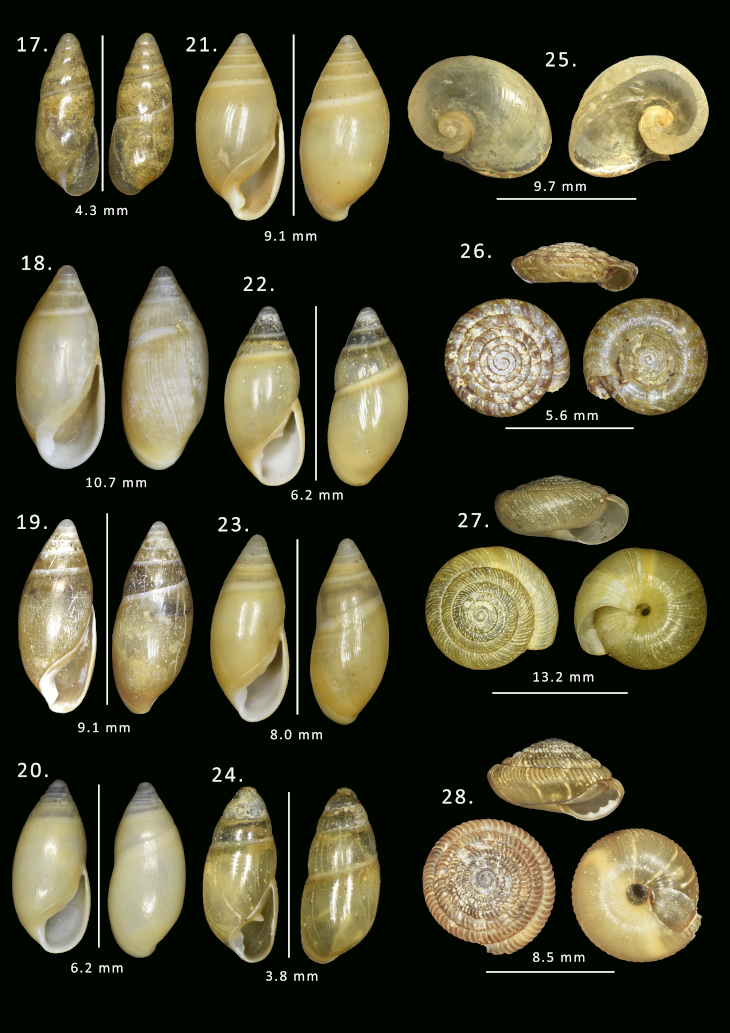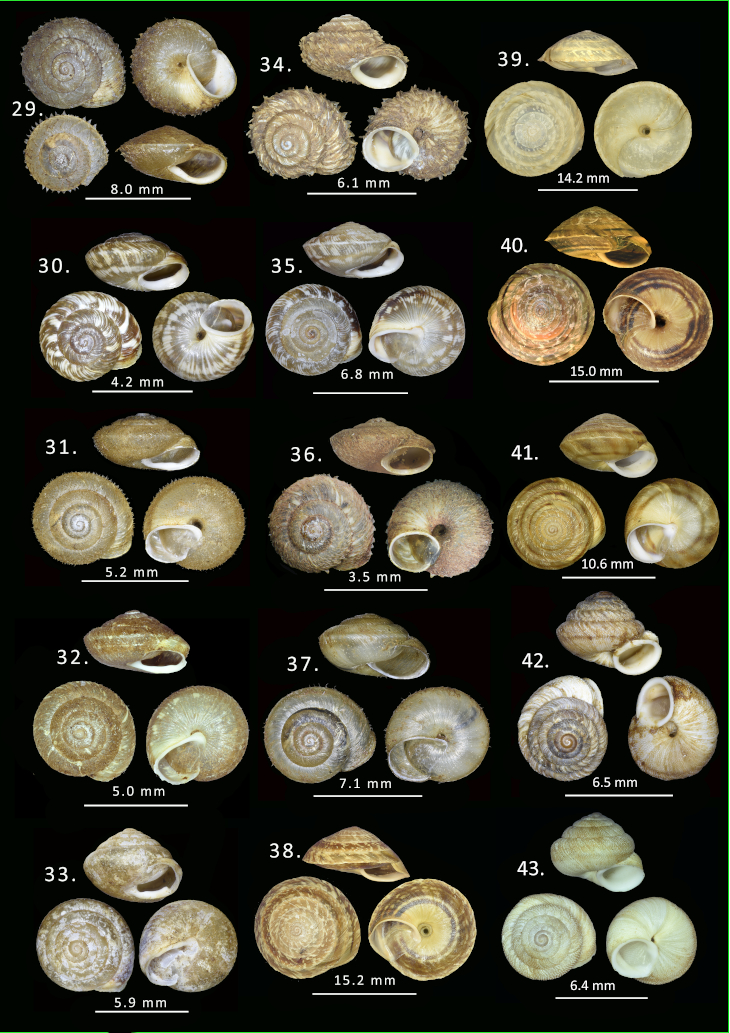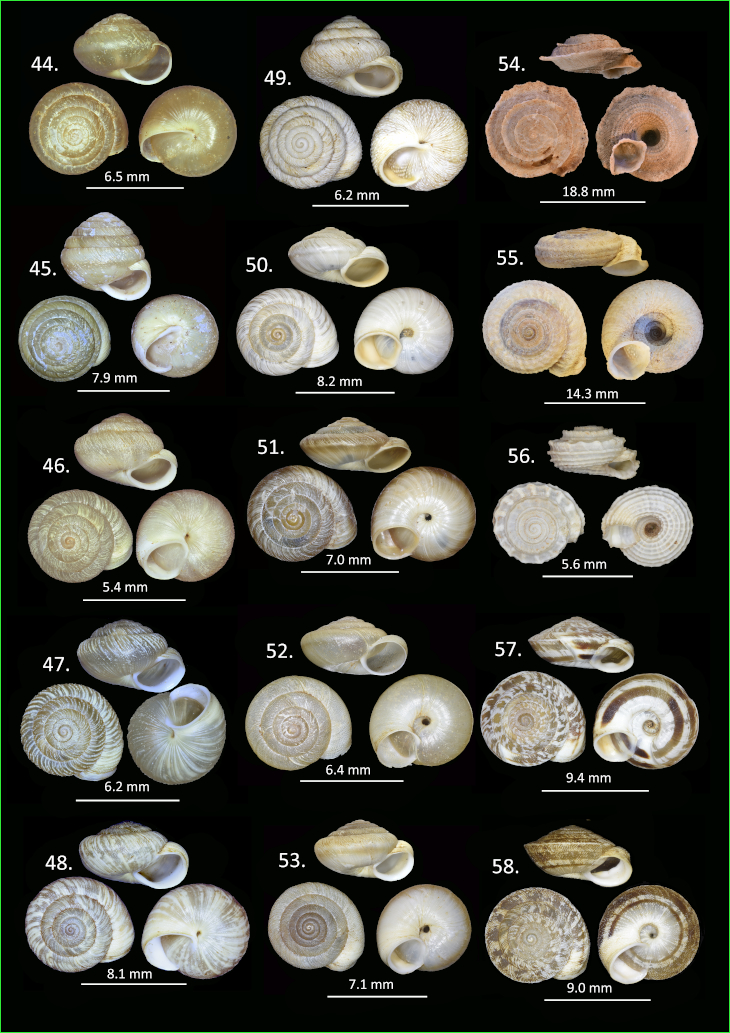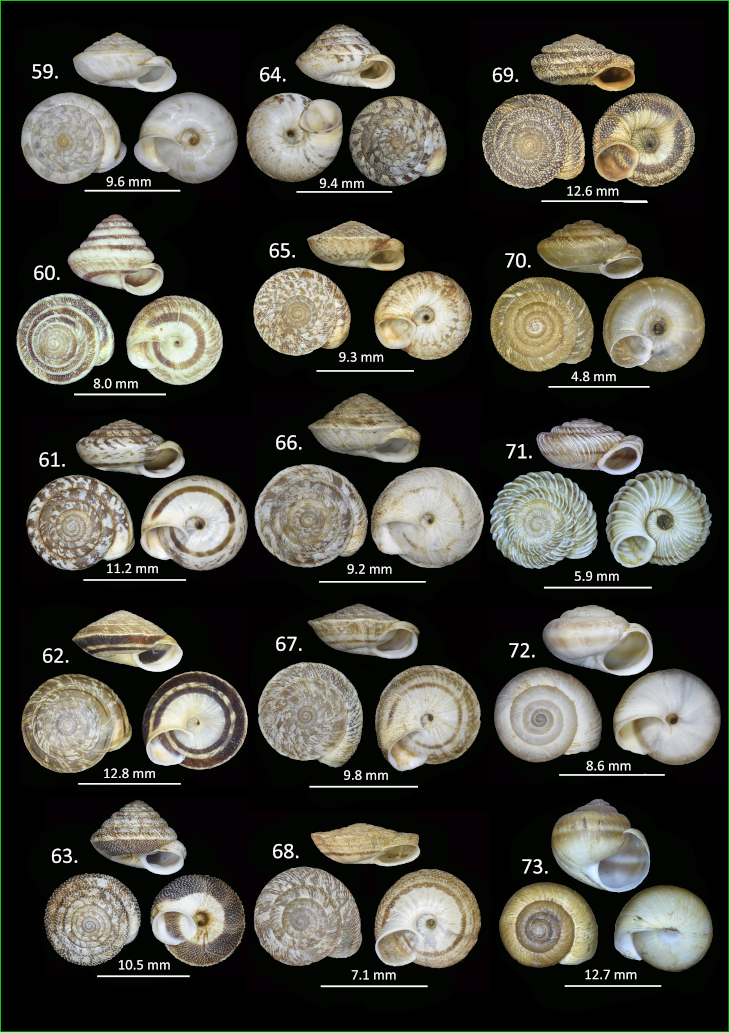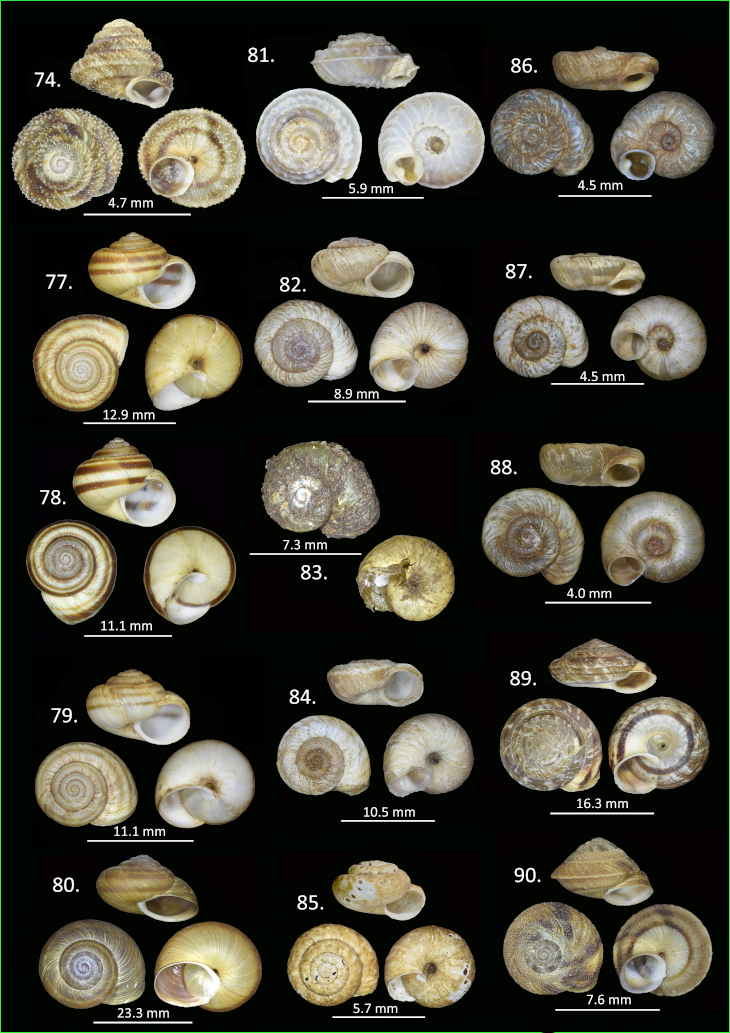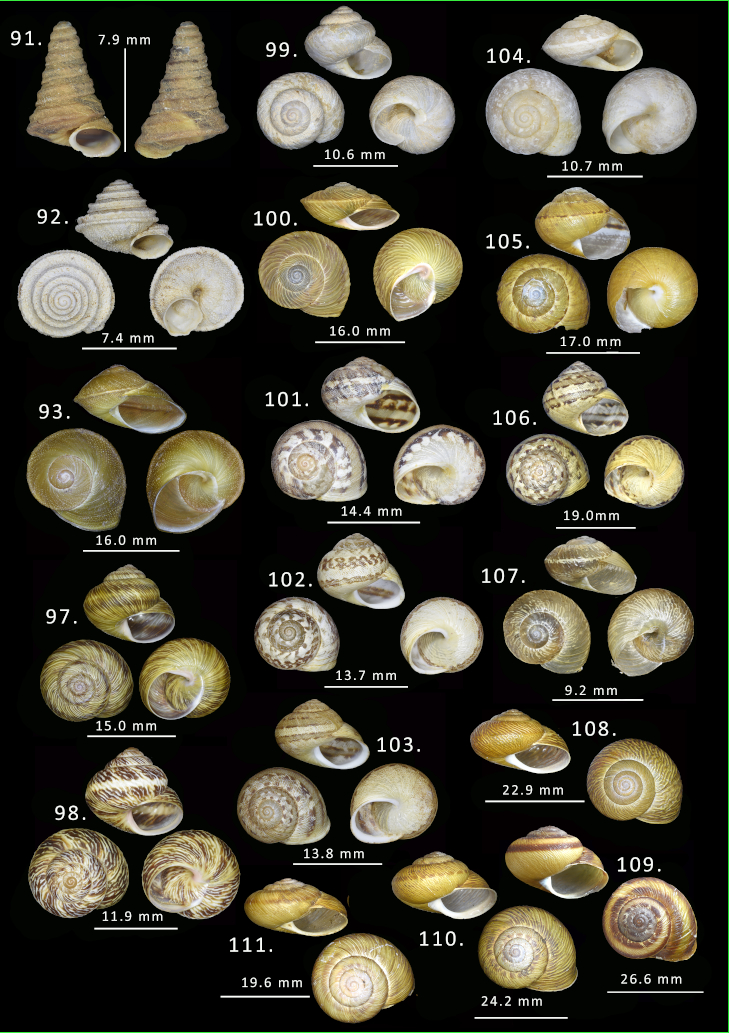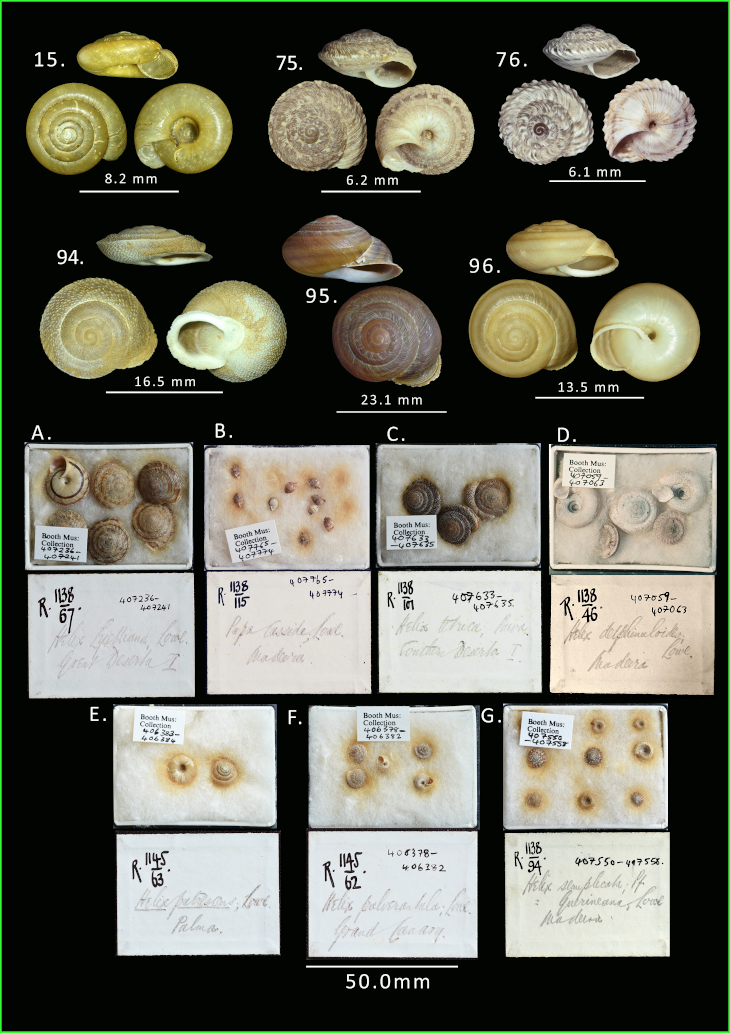Type specimens of Macaronesian land snails described by R. T. Lowe held in the Booth Museum, Brighton
A forgotten taxonomic resource
Les spécimens types des mollusques terrestres de Macaronésie décrits par R. T. Lowe et conservés au Booth Museum, Brighton
Une ressource taxinomique oubliée
- P. Graham Oliver, Klaus Groh & Lee Ismail
|
Type specimens of 103 species, in 111 lots, of land molluscs from Madeira and the Canary Islands described by R. T. Lowe have been found in the Booth Museum, Brighton. The collections were donated by Col. L. Worthington-Wilmer in 1911 and were selected from the collection of R. T. Lowe. An exemplar from each type lot is illustrated and the references for the original descriptions and type localities are given. Keywords: Madeira - Canary Islands - terrestrial Mollusca - Col. L. Worthington-Wilmer - R. T. Lowe - T. V. Wollaston - syntypes Les spécimens types de 103 espèces en 111 lots, de mollusques terrestres de Madère et des îles Canaries, décrits par R. T. Lowe, ont été trouvés au Booth Museum, Brighton. Les séries ont été données par le colonel L. Worthington-Wilmer en 1911 et ont été sélectionnées dans la collection de R. T. Lowe. Un exemplaire de chaque lot type est illustré et les références des descriptions originales et des localités types sont données. Mots clés : Madeira - îles Canaries - mollusques terrestres - colonel L. Worthington-Wilmer - R. T. Lowe - T. V. Wollaston - syntypes |
The donor : Lt. Col. Lewis Worthington-Wilmer (1838–1923)
The collector : Richard Thomas Lowe (1802–1874)
A possible second source : Thomas Vernon Wollaston (1822-1878)
Catalogue of the Type Material of Species described by R. T. Lowe in the Booth Museum, Brighton
|
In the United Kingdom important taxonomic collections containing type specimens are often assumed to be held by national, larger municipal or university museums. However, recent work through the "Mollusca Types in GB & Ireland" project (Ablett et al., 2018, https://gbmolluscatypes.ac.uk) has revealed that many smaller museums hold type specimens. These range from small independent museums such as Tenby in Wales (Oliver et al., 2020) to city museums such as Exeter (Oliver et al., 2017). In 2021 the first author visited the Booth Museum of Natural History in Brighton, England to assess the collections of Mollusca and make recommendations on their significance and potential roles (Oliver, 2022, confidential report for Royal Pavilion and Museums, Brighton). The Booth Museum 1 (Fig. 1) was built in 1874 to house the private collection of Edward Thomas Booth 1 (1840–1890) and became a public museum in 1890. Booth was a pioneer of preparing mounted birds in a natural backdrop and was the first to exhibit his dioramas (Fig. 2), for which the museum remains renowned. The collection of south and Central American butterflies is also documented (Legg, 1984) but the Mollusca have been largely ignored.
The review by Oliver (2022) found that the there was a good representation of the land and freshwater molluscs of the south-east of England typified by the Jenner collection (Fig. 3) (Jenner, 1891) and of subtropical and tropical land snails typified by the Tulk-Hart (1847–1920) collection (Fig. 4). Undoubtedly this collection contains many rare, endangered or even extinct species but the provenance of this material is obscure rendering it of little taxonomic value.
A miscellany of late Victorian material contained some shells exchanged or purchased through Sowerby & Fulton 2, Ronald Winckworth 3 and J. R. Le B. Tomlin 4. Among the general collection were many shells attributed to a Col. Worthington-Wilmer but in two drawers were selections of neatly arranged boxes of land snails from the Macaronesian islands of Madeira and the Canaries (Fig. 5). The drawer of Madeiran species was immediately of interest as it indicated that these boxes were once part of the R. T. Lowe collection, the pioneer of Madeiran land snail descriptions from 1831 to 1861. These shells were donated by Col. Louis Worthington-Wilmer in August 1911 and the museum register states “Selection of the Madeira section of the collection of shells formed by the late Rev. Canon Lowe” and then against a type list of the shells “Catalogue of the Madeira section of the collection of Shells got together by the late Rev. Canon Lowe”. This drawer contains 130 lots, the majority of species described by Lowe. A second donation in October of the same year consists of shells from the Canary islands, 82 lots plus another three from Madeira and Cape Verde islands. These collections were initially donated to the Brighton Museum and Art Gallery and were transferred to the Booth Museum in 1971 when it was incorporated into the “Royal Pavilion & Museums, Brighton and Hove”.
The collections consist of neatly arranged shells in glass-topped boxes, resting on cotton wool (Plate 8A–E). Most lots contain multiple examples of each species ranging in number from three to thirty-three. They are labelled on the reverse in pencil giving identity and locality, these are not in Lowes handwriting and we do not have examples from Worthington-Wilmer. The reverse carries an original Brighton Museum registration number in the form R 1138/1-130 for the first donation and R1145/1-82 for the second donation where the first number is the accession number and the second the lot number. In the last few years a second registration has been added, with an individual number for each shell, these in the form of a running number, e.g. 406458–406462. Note that in the Booth Museum's digital database these numbers are prefixed with BV and this should be used if enquiring about any of the material listed here. The reference directly to Lowe suggested that these shells may have type status and were at least of historic significance. This paper describes this collection, discusses their significance and determines the type status of those lots containing species described by Lowe. A subsequent paper (in prep.) will bring together a compendium of all known, accepted and potential, type lots held in museums in Europe and North America. That paper will discuss the provenances of the collections and propose a hierarchy of significance.
The Donor - Lt. Col. Lewis Worthington-Wilmer (1838–1923) Lewis Worthington-Wilmer (often abbreviated to L.W. Wilmer) was part of a military family and joined the army at the age of 17 and then served with distinction during the Indian Mutiny of 1857/58. There are no indications of an early interest in natural history but in India he dredged many marine gastropods from the Andaman Islands. He donated this collection to the British Museum (Natural History) (BMNH) now Natural History Museum United Kingdom (NHMUK) in 1878 and seventy-five were subsequently described by E. A. Smith (1879) including the patronym Pleurotoma wilmeri E. A. Smith, 1879. Once retired we see him developing a range of activities not only in natural history but in archaeology and numismatics. Evidence of these activities are present in his donations to the Brighton museum and those relevant to conchology are listed below. His association with the Brighton Museum can be traced to 1886 when a note in the Minutes of the Pavilion Museum, Brighton suggests sending shells to Col. Worthington-Wilmer for identification “Vol. 15, p. 171, 6 September 1886: Resolved that the shells be sent to Colonel Wilmer of 12 Gunderstone Road, West Kensington to name”. In 1910 he begins a series of donations of shells: 1910 – 28 lots of land snails from Bermuda ex A. J. Peile 5 Conchology was perhaps his main interest and he was a founder member of the Malacological Society of London in 1893 and a council member from 1897/9. He regularly attended meetings and participated in discussions on nomenclature (Burne, 1904) and making short communications (Wilmer, 1917). Although a regular attendee and accomplished field naturalist he did not develop a research interest but exhibited at meetings of the Malacological Society. 6 He however is recognised in a number of patronyms Clavus wilmeri (E. A. Smith, 1879): Cancellaria wilmeri G. B. Sowerby III, 1881: Conus wilmeri G. B. Sowerby III, 1882; Gyrineum wilmerianum Preston, 1908: Drillia worthingtoni E. A. Smith, 1904. In his obituary Bullen Newton (1923) indicates that Worthington-Wilmer's collection amounted to 40,000 shells but this far exceeds his donations to Brighton. It is not known what became of this collection. We have no evidence that Worthington-Wilmer acquired the Madeiran shells directly from Lowe although the implication in the Brighton register is that the shells came from Lowe's own collection. However, this could also have come about if Worthington-Wilmer had access to the collection once it had been acquired by Wollaston either directly through T. V. Wollaston or his wife Edith who has possession of the entire Lowe/Wollaston material after her husband's death in 1878 until she sold it to Hugh Berthon Preston 7 in 1907. It is possible that Worthington-Wilmer could have met both Lowe and Wollaston, for he was aged 36 when Lowe died and 40 when Wollaston died. Worthington-Wilmer is not only connected with Madeiran shells through the Booth collection for in 1968 a collection of Madeiran land snails considered to consist of potential syntypes was donated to the NHMUK by a John Cooper (Accession Number 2122). This collection was said to have been put together by Worthington-Wilmer and had been part of the Castle Turner and Farrenden collections. Information on none of the three names mentioned here could be found. This collection consisted mostly of lots with one example only and represented only 33 species compared with the 103 species in the Booth collection, never-the-less the collection was subsequently registered as a set of syntypes. A third connection came to light in the National Museums Scotland where a number of lots in the A.E. Salisbury 8 collection are annotated “Lowe Coll. ex Col. Wilmer”. This suggests that Worthington-Wilmer either had continuing access to the Lowe material or that he had acquired sufficient to make duplicate collections.
The Collector : Richard Thomas Lowe (1802–1874) The following brief account of R. T. Lowe is derived primarily from the studies of Lowe as a botanist by Sandra Mesquita and her colleagues (Mesquita et al., 2020 ; 2021 ; 2022) and the entry in the Oxford Dictionary of National Biography (Foote, 2004). Lowe was a graduate of Christ's College Cambridge and took holy orders in 1825. At Cambridge he became interested in natural history and joined a group of students who participated in botanizing tours under the supervision of J. S. Henslow, renowned as Darwin's mentor (Walters & Stow, 2001). Other students accompanying Lowe were Miles Joseph Berkeley (1803-1889) (Taylor, 1970) the eminent lichenologist, whom Lowe later named a species for. It was here that Lowe became acquainted with Thomas Vernon Wollaston (1822-1878) (see below) with whom he maintained a deep friendship throughout his life. Henslow was a founder of the Cambridge Philosophical Society in whose journal Lowe would publish his first major paper (Lowe, 1831). Lowe first went to Madeira in 1826 and embarked on making comprehensive collections of plants (Mesquita et al., 2021), shells (e.g. Lowe, 1831) and eventually fishes (Lowe, 1843). In the early years on Madeira he was in frequent correspondence 8 with Philip Barker Webb (1793–1854) who was also a Christ's College graduate and was living on Tenerife from 1829-1830. Webb like Lowe was a collector of both plants and shells and published a nine-volume work on the natural history of the Canary Isles but specifically on shells in Webb & Berthelot (1833). Most of the correspondence with Webb 9 concerns Botany (Mequita et al., 2021) but a few pages are dedicated to molluscs (Fig. 6).
Lowe lived on the island as a clergyman causing considerable disquiet through his adherence to Tractarianism (Nash, 1990) and was finally forced to give up his position in 1847. He returned to live in England but continued to make excursions to Madeira until his untimely death in 1874 as a result of being lost at sea following a shipwreck. Lowe wrote eleven papers on the land Mollusca of Madeira, Mogador and the Canary Islands with the majority of his new taxa in just three major papers (Lowe, 1831 ; 1852 ; 1855). Altogether he described 222 nominal species with additional varieties identified by Greek letters only. Lowe did not recognise the concept of type specimens and did not designate type material for any of his papers. Surprisingly, Lowe only deposited three lots of land snail to the then British Museum of Natural History including the very rare Helix delphinuloides Lowe, 1860 This donation was made in 1860 and others from then through to 1873 concerned marine Mollusca and assorted invertebrates amounting to no more than 20 lots. Lowes failure to deposit significant collections of land snail may have been due to his untimely death. However, in 1850 Wollaston donated a collection of Madeiran land snails to the BM (NH), most of which had been described by Lowe and were probably collected by Lowe. As a consequence of Lowe's reluctance or his untimely death the vast majority of Lowe's collection was donated after his death, primarily via Wollaston who had inherited Lowe's materials. In a sequel to this paper (Oliver et al., in prep.) the entirety of the deposition of Lowes collection and the extent of potential type material will be explored.
A Possible Second Source : Thomas Vernon Wollaston (1822-1878) Thomas Vernon Wollaston befriended Lowe while at Christ's College Cambridge and was also part of the circle of naturalists around J. S. Henslow. Wollaston's main interest was in entomology, primarily Coleoptera (beetles) but after visiting Madeira in 1847 he with Lowe studied Mollusca. After staying on Madeira during the winter of 1847-48 he made four more visits, the last in 1855. In 1858 and 1859 he and Lowe visited the Canary Islands. In 1866 they expanded their horizons and visited the Cape Verde Islands and then in 1875 Wollaston along with John Gray visited St. Helena. Wollaston was greatly interested in biogeography and brought together his work with Lowe in his “Testacea Atlantica” (Wollaston, 1878). In the preface he makes it clear that he had possession of Lowe's collection : “Nevertheless I should hardly have been inclined to undertake so serious a task as the critical examination of the characters and habitats of so many species, had not the bequeathment to me by Mr. Lowe of his extensive conchological collections (to be distributed to various Museums, though with power to reserve for my own use whatever types I might require) thrown on to my hands a mass of material so unexpected”. Although the statement above suggests that Lowe's collection was destined for various museums Wollaston made only two donations both in 1875 the year after Lowe's death; one to the British Museum (Natural History) comprising 120 species and one to the Zoological Museum of Cambridge University comprising 88 species. Neither of these donations were in any way comprehensive of the 222 nominal taxa described by Lowe. Wollaston's synthesis contains fifty-two new species but half of these are at the subspecies or varietal level and most are from islands other than Madeira. Wollaston died in the same year that his Testacea Atlantica was published and the Lowe/Wollaston collection reverted to Wollaston's widow Edith (née Shepherd). |
|
This collection has both historic biodiversity and nomenclatural significance. Firstly the land snail faunas of the Macaronesian Islands are highly diverse with a patchwork of endemic species often occupying limited geographical areas (Cook, 2008). With increasing anthropogenic changes many species are vulnerable, threatened, critically endangered and some possibly extinct (Neubert et al., 2019a, b). Following the IUCN Red List categories in Neubert et al. (2019a, b), within the Booth collection there are fourteen listed as Vulnerable; seven as Endangered; ten as Critically Endangered and seven as Critically Endangered/Possibly Extinct. The latter seven are Leiostyla cassida, Craspedaria delphinuloides, Discula lyelliana, D. tetrica, Monileria pulverulenta, Canaridiscus putrescens and Atlantica guerinianus (Plate 8 A-G). Lowe did not designate type specimens in any of his publications, nor did he personally lodge all but three of his species in any museum. Wollaston did deposit Lowe material in London and Cambridge but did not give them any type status. Once the collection passed to Wollaston's widow Edith she sold some of it to other museums and eventually all of it to H. B. Preston in 1907. However, she must have retained some material because after her death her sister donated a collection to Exeter in 1911 which, in part, was assumed to contain shells figured in Lowe's 1831 paper (currently under review). As there were no designated types Preston assumed that any material coming from the Lowe collection could be considered of type status and sold many duplicates as "co-types". This material has now been given syntypes status in museums such as in Cardiff, Manchester and Liverpool, (see https://gbmolluscatypes.ac.uk/specimens?-action=search&Keywords=Lowe). The 1968 donation to London which is linked to Worthington-Wilmer has also been given syntype status and indeed examples from this collection have been chosen as lectotypes. Given the many collections that are now considered to be of type status we propose that the specimens of species described by Lowe in the Booth Museum can also be given syntype status. A fuller discussion of the type status of specimens in a dispersed collection will be given in a subsequent paper where the full extent of the possible 7,000 type specimens from the Lowe collection will be itemised and discussed. A catalogue of the type material of species described by R. T. Lowe in the Booth Museum is presented below. The format of the catalogue is as follows: Paragraph 1, original name given by Lowe; publication and page number in [ ]; type locality. Paragraph 2, type status. Paragraph 3, Identification and locality given on the reverse of each box. Paragraph 4, number of specimens followed by the Booth Museum registration numbers. Paragraph 5, the current name. The current name mostly follows that in MolluscaBase but there is a considerable amount of flux and uncertainty that the current name may be modified here by Klaus Groh. The current European conservation status, as given in Neubert et al. (2019a, b), is indicated after the accepted name, as follows: Least Concern (LC), Data Deficient (DD), Near Threatened (NT), Vulnerable (VU), Endangered (EN), Critically Endangered (CR) or Critically Endangered/Possibly Extinct (CR/PE). Subfossil and fossil species are suffixed with †.
Catalogue of the Type Material of Species described by R. T. Lowe in the Booth Museum, Brighton |
|
FAMILY COCHLICOPIDAE Cochlicopa A. Férussac, 1821 1. pl. 1 FAMILY TRUNCATELLINIDAE Truncatellina R. T. Lowe, 1852 2. pl. 1 Columella Westerlund, 1878 3. pl. 1 FAMILY LAURIIDAE Lauria Gray, 1840 4. pl. 1 |
Leiostyla Lowe, 1852 5. pl. 1 6. pl. 1 7. pl. 1 8. pl. 1 9. pl. 1 |
|
|
10. pl. 1 Leiostyla (Craticula) Lowe, 1852 11. pl. 1 12. pl. 1 13. pl. 1 Leiostyla (Scarabella) Lowe, 1855 14. pl. 1 |
FAMILY DISCIDAE Canaridiscus Alonso & Ibáñez, 2011 15. pl. 8 FAMILY PUNCTIDAE Paralaoma Iredale, 1913 16. pl. 1 Family FERUSSACIIDAE Amphorella R. T. Lowe, 1852 17. pl. 2 18. pl. 2 |
|
|
19. pl. 2 20. pl. 2 21. pl. 2 22. pl. 2 23. pl. 2 |
Cylichnidia R. T. Lowe, 1852 24. pl. 2 FAMILY VITRINIIDAE Madeirovitrina Groh & Hemmen, 1986 25. pl. 2 FAMILY GASTRODONTIDAE Atlantica Ancey, 1887 26. pl. 2 Janulus Lowe, 1852 27 pl. 2
|
|
|
28. pl. 2 FAMILY GEOMITRIDAE Actinella R. T. Lowe, 1852 29. pl. 3 30. pl. 3 31. pl. 3 32. pl. 3 33. pl. 3 |
34. pl. 3 35. pl. 3 36. pl. 3 37. pl. 3 Callina R. T. Lowe, 1855 38. pl. 3 39. pl. 3 |
|
|
40. pl. 3 41. pl. 3 Caseolus R. T. Lowe, 1852 42. pl. 3 43. pl. 3 44. pl. 4 45. pl. 4 |
46. pl. 4 47. pl. 4 48. pl. 4 49. pl. 4
|
|
|
Leptostictea Mandahl-Barth, 1950 50. pl. 4 51. pl. 4 52. pl. 4 53. pl. 4 Craspedaria R. T. Lowe, 1852 54. pl. 4 55. pl. 4 |
Syntypes. 56. pl. 4 Discula R. T. Lowe, 1852 57. pl. 4 58. pl. 4 59. pl. 5 60. pl. 5 |
|
|
61. pl. 5 Helix (Helicella) lincta R. T. Lowe, 1852 Lowe, R. T. (1852) [p. 116] “in Madera” [= Madeira] 62. pl. 5 63. pl. 5 64. pl. 5 65. pl. 5 66. pl. 5 Helix (Discula) senilis R. T. Lowe, 1852 Lowe, R. T. (1852) [p. 116] “in Insulis Desertis Majore et Minore” [Deserta Grande and Bugio] |
Syntypes. 67. pl. 5 68. pl. 5 69. pl. 5 Disculella Pilsbry, 1895 70. pl. 5 71. pl. 5 |
|
|
Domunculifex Brozzo, De Mattia, Harl & Neiber, 2020 72. pl. 5 Helicomela Lowe, 1855 73 pl. 5 Hystricella R. T. Lowe, 1855 74. pl. 6 Monilearia Mousson, 1872 75. pl. 8 Obelus W. Hartmann, 1842 76. pl. 8 |
Plebecula R. T. Lowe, 1852 77. pl. 6 78. pl. 6 79. pl. 6 Pseudocampylaea L. Pfeiffer, 1877 80. pl. 6 Serratorotula Groh & Hemmen, 1986 81. pl. 6 |
|
|
Spirorbula R. T. Lowe, 1852 82. pl. 6 83. pl. 6 Helix (Spirorbula) latens R. T. Lowe, 1852 Lowe, R. T. (1852) [p. 114-115] “in Madera” [= Madeira] 84. pl. 6 85. pl. 6 Steenbergia Mandahl-Barth, 1950 86. pl. 6 Helix (Helicella) paupercula R. T. Lowe, 1831 Lowe, R. T. (1831) [p. 47-48, pl. 5 fig 19]. “in Maderae et Portȗs Sti. maritimis” [= Madeira and Porto Santo, coastal] |
87. pl. 6 88. pl. 6 Testudodiscula Brozzo, De Mattia, Harl & Neiber, 2020 89. pl. 6 Wollastonaria De Mattia, Neiber & Groh, 2018 90. pl. 6 91. pl. 7 |
|
|
Topotypes. Lectotype NHMUK 1948.7.8.35 by De Mattia et al. (2018): 56-62. 92. pl. 7 FAMILY HELICIDAE Lampadia Albers, 1854 93. pl. 7 Syntypes. Hemicycla Swainson, 1840 94. pl. 8 95. pl. 8 96. pl. 8 |
[under stones in dry barren places and in higher pine woods, St Bartholomei, El Charco, Maspalomas, Arguineguin etc.] FAMILY HYGROMIIDAE Leptaxis (Katostoma) R. T. Lowe, 1855 97. pl. 7 98. pl. 7 99. pl. 7 100. pl. 7 |
|
|
Leptaxis (Leptaxis) R. T. Lowe, 1831 101. pl. 7 102. pl. 7 103. pl. 7 104. pl. 7 105. pl. 7 106. pl. 7 |
Syntypes. 107. pl. 7 Leptaxis (Cryptaxis) R. T. Lowe, 1855 108. pl. 7 109. pl. 7 110. pl. 7 111. pl. 7 |
|
|
The senior author wishes to acknowledge the financial support from John Ellerman Foundation’s Regional Museums and Galleries Fund. as part of the project “Mollusca Types in Great Britain & Ireland”. |
|
Ablett J. D., Gallichan J., Holmes A., Oliver G., Rowson B., Salvador A., Turner J. & Wood H., 2018. Mollusca Types in Great Britain: founding a union database. Journal of Natural Science Collections, 6: 15–30. Badcock E. C. 1964. Obituary, A. E. Salisbury, 1876-1964. Journal of Conchology, 25: 293–298. Bullen Newton R., 1923. Obituary. Col. L. Worthington-Wilmer, 1838–1923. Proceedings of the Malacological Society of London, 15: 239–240. Burne R. H., 1904. Summary of the discussion at the meeting held on June 10th upon the two following questions of nomenclature. Proceedings of the Malacological Society of London, 6: 130–131. Cook I. M., 2008. Species richness in Madeiran land snails, and its causes. Journal of Biogeography, 35 (4): 647-653. De Mattia W., Neiber M.T & Groh K., 2018. Revision of the genus-group Hystricella R. T. Lowe, 1855 from Porto Santo (Madeira Archipelago), with descriptions of new recent and fossil taxa (Gastropoda, Helicoidea, Geomitridae) Zookeys (732): 1–125. Ellis A. E., 1950. Obituary, Ronald Winckworth. Journal of Conchology, 23: 157–162. Foote Y., 2004. Lowe, Richard Thomas (1802–1874), naturalist. Oxford Dictionary of National Biography. doi: https://doi.org/10.1093/ref:odnb/17087 (accessed 25 October 2022). Foote Y., 2008. Wollaston, Thomas Vernon (1822–1878), entomologist and conchologist. Oxford Dictionary of National Biography. doi: https://doi.org/10.1093/ref:odnb/29840 (accessed 25 October 2022). Hutterer R. & Groh K. (1993). A review of Macaronesian Truncatellina (Gastropoda: Vertiginidae) with descriptions of four new species. Bocagiana, 151 [1991]: 1-19. Legg G., 1984. Arthur Hall: Butterfly Collector. Biology Curators Group Newsletter, 3 (10): 588. Lowe R. T., 1831. Primitiae faunae et florae Maderae et Portus Sancti; sive species quaedam novae vel hactenus minus rite cognitae animalium et plantarum in his insulis degentium breviter descriptae. Transactions of the Cambridge Philosophical Society, 4 (1): 1–70, pls. 1–6. Lowe R. T., 1852. Brief diagnostic notices of new Madeiran land shells. The Annals and Magazine of Natural History, (2) 9 (50): 112–120; (2) 9 (52): 275–279. Lowe R. T., 1853. Primitiae et Novitiae Faunae et Florae Maderae et Portus Sancti or Two Memoirs on the Ferns, Flowering plants, and Land Shells of Madeira and Porto Santo with an appendix. London, J. Van Voorst. Lowe R. T., 1855 ["1854"]. Catalogus molluscorum pneumonatorum insularum Maderensium: or a list of all the land and freshwater shells, recent and fossil, of the Madeiran islands: arranged in groups according to their natural affinities; with diagnoses of the groups, and of the new or hitherto imperfectly defined species. Proceedings of the Zoological Society of London, 22: 161–208; 209–218. Lowe R. T., 1860. Description of a new Helix; and notice of the occurrence of Planorbis glaber, Jeffr., in Madeira. The Annals and Magazine of Natural History, (3) 6 (31): 42–46. Lowe R. T., 1860. The Cyclostomas of Madeira belonging to the genus Craspedopoma of Pfeiffer: with descriptions of four new Madeiran and one new Canarian species. The Annals and Magazine of Natural History, (3) 6 (32): 114–118. Lowe R. T., 1861. A list of shells observed or collected at Mogador and in its immediate environs, during a few days' visit to the place, in April 1859. Proceedings of the Zoological Society of London, 1860: 169–204. Lowe R. T., 1861. Diagnoses of new Canarian land-Mollusca. The Annals and Magazine of Natural History, (3) 7 (38): 104–112. Lowe R. T., 1862. Notice of the discovery, by the Barao do Castello De Pavia, of the fossil Helix coronula recent, and of other new land-Mollusca, in Madeira. The Annals and Magazine of Natural History, (3) 10 (56): 93–96. Lowe R. T., 1863. Description of two new Madeiran land-shells lately discovered by the Barao De Paiva and Sr J.M. Moniz. The Annals and Magazine of Natural History. (3) 12 (71): 338–340. Lowe R. T., 1867. Description of a new Madeiran Pupa. The Annals and Magazine of Natural History, (3) 19 (110): 81–82. Mesquita S., Carine M., Castel-Branco C. & Menezes de Sequeira M., 2022. Documenting the flora of a diversity hotspot: Richard Thomas Lowe (1802–1874) and his botanical exploration of Madeira island. Taxon, 71 (4): 876–891. Mesquita S., Castel-Branco C. & Menezes de Sequeira M., 2020. Richard Thomas Lowe, an unknown botanical illustrator. Revista Scientia Insularum, 3: 59–71. Mesquita S., Menezes de Sequeira M. & Castel-Branco C., 2021. Richard Thomas Lowe (1802-1874) and his correspondence networks: botanical exchanges in Madeira. Archives of Natural History, 48 (2): 377–395. Supporting information at (https://doi.org/10.3366/anh.2021.0729) Neubert E., Seddon M.B., Allen D.J., Arrébola J., Backeljau T., Balashov I., Bank R., Cameron R., de Frias Martins A.M., De Mattia W., Dedov I., Duda M., Falkner G., Falkner M., Fehér Z., Gargominy O., Georgiev D., Giusti F., Gómez Moliner B.J., Groh K., Ibáñez M., Kappes H., Manganelli G., Martínez-Ortí A., Nardi G., Neiber M.T., Páll-Gergely B., Parmakelis A., Prié V., Reischütz A., Reischütz P.L., Rowson B., Rüetschi J., Slapnik R., Son M., Štamol V., Teixeira D., Triantis K., Vardinoyannis K., von Proschwitz T. & Walther F., 2019a. European Red List of Terrestrial Molluscs. Cambridge, UK and Brussels, Belgium: IUCN. 23 pp. https://portals.iucn.org/library/node/48439 Neubert E., Seddon M.B., Allen D.J., Arrébola J., Backeljau T., Balashov I., Bank R., Cameron R., de Frias Martins A.M., De Mattia W., Dedov I., Duda M., Falkner G., Falkner M., Fehér Z., Gargominy O., Georgiev D., Giusti F., Gómez Moliner B.J., Groh K., Ibáñez M., Kappes H., Manganelli G., Martínez- Ortí A., Nardi G., Neiber M.T., Páll-Gergely B., Parmakelis A., Prié V., Reischütz A., Reischütz P.L., Rowson B., Rüetschi J., Slapnik R., Son M., Štamol V., Teixeira D., Triantis K., Vardinoyannis K., von Proschwitz T. & Walther F., 2019b. Supplementary Material to the European Red List of terrestrial molluscs. Cambridge, UK: IUCN. 79 pp. https://portals.iucn.org/library/node/48439 Nash R., 1990. Scandal in Madeira, the story of Richard Thomas Lowe. Surrey, The Book Guild, 187 pp. Oliver P. G., Talbot K., Fredriksson B., Tomlinson V., Lewis M. & Fraser D., 2020. William Lyons of Tenby (1776–1849) and his conchology collection in the Tenby Museum & Art Gallery with recognition of type material. Colligo, 3 (1). https://perma.cc/DYJ7-TUEN Oliver P. G., Morgenroth H. & Salvador A., 2017. Type specimens of Mollusca described by Col. George Montagu in the Royal Albert Memorial Museum & Art Gallery, Exeter and The Natural History Museum, London. Zoosystematics and Evolution, 93 (2): 363–492. Petit R. E., 2009. George Brettingham Sowerby, I, II, & III: their conchological publications and Molluscan taxa. Zootaxa, 2819: 1-218. Seddon, M. B., 2008. The Landsnails of Madeira. An illustrated compendium of the landsnails and slugs of the Madeiran archipelago. Studies in Biodiversity and Systematics of Terrestrial Organisms from the National Museum of Wales. Biotir Reports, 2: 204 pp. Taylor G., 1970. "Berkeley, Miles Joseph". Dictionary of Scientific Biography, 2: 18–19. Trew A., 1990. John R. le B. Tomlin's New Molluscan Names. National Museum of Wales. Cardiff, 101 pp. Walters S. M. & Stow E. A. 2001. Darwin's Mentor: John Stevens Henslow, 1796–1861. Cambridge, Cambridge University Press, 338 pp. Webb P. B. & Berthelot S., 1833. Synopsis molluscorum terrestrium et fluviatilium quae in itineribus per insulas Canarias. Annales des Sciences Naturelles, 28: 307–326. Wilmer L. W. 1917. Note on Crioceras bowerbankii (J. de C. Sowerby). Proceedings of the Malacological Society of London, 12 (6): 308. Winckworth R., 1946. Obituary, High Berthon Preston. Proceedings of the Malacological Society of London, 27 (1):4–5 Winckworth R., 1949. Obituary: Alfred James Peile 1868–1948. Proceedings of the Malacological Society of London, 28 (1): 5–7. Wollaston T. V., 1878. Testacea Atlantica or the land and freshwater shells of the Azores, Madeiras, Salvages, Canaries, Cape Verdes, and Saint Helena. London, Reeve, 588 pp. |
|
|
P. Graham Oliver Klaus Groh Lee Ismail |
| Oliver P. G., Groh K. & Ismail L., 2022. Type specimens of Macaronesian land snails described by R. T. Lowe held in the Booth Museum, Brighton. A forgotten taxonomic resource. Colligo, 6(1). https://revue-colligo.fr/?id=82. |

